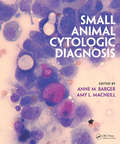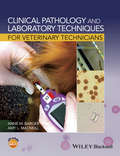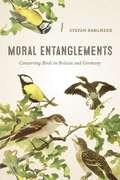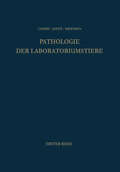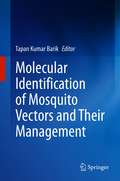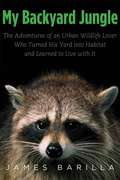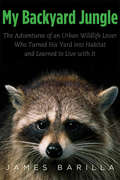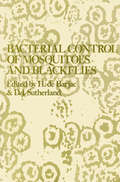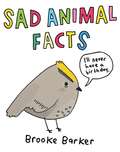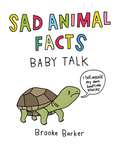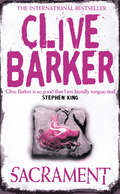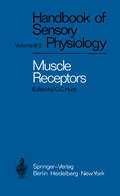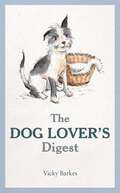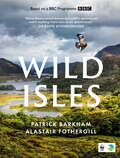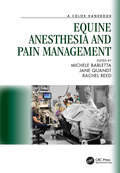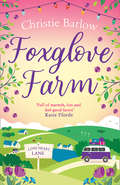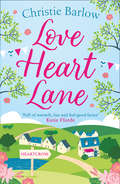- Table View
- List View
Small Animal Cytologic Diagnosis
by Anne M. Barger Amy MacNeillA powerful tool that can be employed in a wide variety of disease processes, cytology in small animals has gained increased recognition and clinical application. Small Animal Cytologic Diagnosis presents clinically applicable information about the use of cytology and indicates when advanced diagnostic testing can be beneficial to diagnose underlying disease processes. The book discusses the pathophysiology of inflammation, cancer biology and comparisons to histology to help readers fully comprehend the cytologic changes that can occur with inflammation and neoplasia. Also covered are some of the limitations and advantages of cytology compared to histopathology. The book includes tissue-specific chapters focusing on diseases of a particular area, always in comparison to normal tissue. Each of these chapters concludes with various cases that include information on signalment, history, pertinent laboratory data, specimen images, final outcome and the underlying pathology causing the cytologic lesions, when possible. With more than 1300 superb illustrations, this comprehensive resource provides ample practical information for students as well as practicing veterinarians.
Clinical Pathology and Laboratory Techniques for Veterinary Technicians
by Anne M. Barger Amy L. MacNeillClinical Pathology and Laboratory Techniques for Veterinary Technicians provides a comprehensive reference of laboratory procedures featuring ‘how-to’ information as it pertains to small animals, horses, and cattle. An inclusive reference on laboratory procedures pertaining to small animals, horses and cattle Provides information on hematology, hemostasis, clinical chemistry, urinalysis, parasitology, and fecal testing Features high-quality photographs labelled with magnification and stain information, which clearly depict cellular morphology, inclusions and infectious organisms Offers key objectives, technician tip boxes, case examples and a glossary of key terms A companion website provides images from the book for download, instructor questions and answer key to multiple choice questions in the book
Clinical Pathology and Laboratory Techniques for Veterinary Technicians
by Anne M. Barger Amy L. MacNeillClinical Pathology and Laboratory Techniques for Veterinary Technicians provides a comprehensive reference of laboratory procedures featuring ‘how-to’ information as it pertains to small animals, horses, and cattle. An inclusive reference on laboratory procedures pertaining to small animals, horses and cattle Provides information on hematology, hemostasis, clinical chemistry, urinalysis, parasitology, and fecal testing Features high-quality photographs labelled with magnification and stain information, which clearly depict cellular morphology, inclusions and infectious organisms Offers key objectives, technician tip boxes, case examples and a glossary of key terms A companion website provides images from the book for download, instructor questions and answer key to multiple choice questions in the book
Moral Entanglements: Conserving Birds in Britain and Germany
by Stefan BargheerAt the center of Stefan Bargheer’s account of bird watching, field ornithology, and nature conservation in Britain and Germany stands the question of how values change over time and how individuals develop moral commitments. Using life history data derived from written narratives and oral histories, Moral Entanglements follows the development of conservation from the point in time at which the greatest declines in bird life took place to the current efforts in large-scale biodiversity conservation and environmental policy within the European Union. While often depicted as the outcome of an environmental revolution that has taken place since the 1960s, Bargheer demonstrates to the contrary that the relevant practices and institutions that shape contemporary conservation have evolved gradually since the early nineteenth century. Moral Entanglements further shows that the practices and institutions in which bird conservation is entangled differ between the two countries. In Britain, birds derived their meaning in the context of the game of bird watching as a leisure activity. Here birds are now, as then, the most popular and best protected taxonomic group of wildlife due to their particularly suitable status as toys in a collecting game, turning nature into a playground. In Germany, by contrast, birds were initially part of the world of work. They were protected as useful economic tools, rendering services of ecological pest control in a system of agricultural production modeled after the factory shop floor. Based on this extensive analysis, Bargheer formulates a sociology of morality informed by a pragmatist theory of value.
Moral Entanglements: Conserving Birds in Britain and Germany
by Stefan BargheerAt the center of Stefan Bargheer’s account of bird watching, field ornithology, and nature conservation in Britain and Germany stands the question of how values change over time and how individuals develop moral commitments. Using life history data derived from written narratives and oral histories, Moral Entanglements follows the development of conservation from the point in time at which the greatest declines in bird life took place to the current efforts in large-scale biodiversity conservation and environmental policy within the European Union. While often depicted as the outcome of an environmental revolution that has taken place since the 1960s, Bargheer demonstrates to the contrary that the relevant practices and institutions that shape contemporary conservation have evolved gradually since the early nineteenth century. Moral Entanglements further shows that the practices and institutions in which bird conservation is entangled differ between the two countries. In Britain, birds derived their meaning in the context of the game of bird watching as a leisure activity. Here birds are now, as then, the most popular and best protected taxonomic group of wildlife due to their particularly suitable status as toys in a collecting game, turning nature into a playground. In Germany, by contrast, birds were initially part of the world of work. They were protected as useful economic tools, rendering services of ecological pest control in a system of agricultural production modeled after the factory shop floor. Based on this extensive analysis, Bargheer formulates a sociology of morality informed by a pragmatist theory of value.
Moral Entanglements: Conserving Birds in Britain and Germany
by Stefan BargheerAt the center of Stefan Bargheer’s account of bird watching, field ornithology, and nature conservation in Britain and Germany stands the question of how values change over time and how individuals develop moral commitments. Using life history data derived from written narratives and oral histories, Moral Entanglements follows the development of conservation from the point in time at which the greatest declines in bird life took place to the current efforts in large-scale biodiversity conservation and environmental policy within the European Union. While often depicted as the outcome of an environmental revolution that has taken place since the 1960s, Bargheer demonstrates to the contrary that the relevant practices and institutions that shape contemporary conservation have evolved gradually since the early nineteenth century. Moral Entanglements further shows that the practices and institutions in which bird conservation is entangled differ between the two countries. In Britain, birds derived their meaning in the context of the game of bird watching as a leisure activity. Here birds are now, as then, the most popular and best protected taxonomic group of wildlife due to their particularly suitable status as toys in a collecting game, turning nature into a playground. In Germany, by contrast, birds were initially part of the world of work. They were protected as useful economic tools, rendering services of ecological pest control in a system of agricultural production modeled after the factory shop floor. Based on this extensive analysis, Bargheer formulates a sociology of morality informed by a pragmatist theory of value.
Moral Entanglements: Conserving Birds in Britain and Germany
by Stefan BargheerAt the center of Stefan Bargheer’s account of bird watching, field ornithology, and nature conservation in Britain and Germany stands the question of how values change over time and how individuals develop moral commitments. Using life history data derived from written narratives and oral histories, Moral Entanglements follows the development of conservation from the point in time at which the greatest declines in bird life took place to the current efforts in large-scale biodiversity conservation and environmental policy within the European Union. While often depicted as the outcome of an environmental revolution that has taken place since the 1960s, Bargheer demonstrates to the contrary that the relevant practices and institutions that shape contemporary conservation have evolved gradually since the early nineteenth century. Moral Entanglements further shows that the practices and institutions in which bird conservation is entangled differ between the two countries. In Britain, birds derived their meaning in the context of the game of bird watching as a leisure activity. Here birds are now, as then, the most popular and best protected taxonomic group of wildlife due to their particularly suitable status as toys in a collecting game, turning nature into a playground. In Germany, by contrast, birds were initially part of the world of work. They were protected as useful economic tools, rendering services of ecological pest control in a system of agricultural production modeled after the factory shop floor. Based on this extensive analysis, Bargheer formulates a sociology of morality informed by a pragmatist theory of value.
Moral Entanglements: Conserving Birds in Britain and Germany
by Stefan BargheerAt the center of Stefan Bargheer’s account of bird watching, field ornithology, and nature conservation in Britain and Germany stands the question of how values change over time and how individuals develop moral commitments. Using life history data derived from written narratives and oral histories, Moral Entanglements follows the development of conservation from the point in time at which the greatest declines in bird life took place to the current efforts in large-scale biodiversity conservation and environmental policy within the European Union. While often depicted as the outcome of an environmental revolution that has taken place since the 1960s, Bargheer demonstrates to the contrary that the relevant practices and institutions that shape contemporary conservation have evolved gradually since the early nineteenth century. Moral Entanglements further shows that the practices and institutions in which bird conservation is entangled differ between the two countries. In Britain, birds derived their meaning in the context of the game of bird watching as a leisure activity. Here birds are now, as then, the most popular and best protected taxonomic group of wildlife due to their particularly suitable status as toys in a collecting game, turning nature into a playground. In Germany, by contrast, birds were initially part of the world of work. They were protected as useful economic tools, rendering services of ecological pest control in a system of agricultural production modeled after the factory shop floor. Based on this extensive analysis, Bargheer formulates a sociology of morality informed by a pragmatist theory of value.
Moral Entanglements: Conserving Birds in Britain and Germany
by Stefan BargheerAt the center of Stefan Bargheer’s account of bird watching, field ornithology, and nature conservation in Britain and Germany stands the question of how values change over time and how individuals develop moral commitments. Using life history data derived from written narratives and oral histories, Moral Entanglements follows the development of conservation from the point in time at which the greatest declines in bird life took place to the current efforts in large-scale biodiversity conservation and environmental policy within the European Union. While often depicted as the outcome of an environmental revolution that has taken place since the 1960s, Bargheer demonstrates to the contrary that the relevant practices and institutions that shape contemporary conservation have evolved gradually since the early nineteenth century. Moral Entanglements further shows that the practices and institutions in which bird conservation is entangled differ between the two countries. In Britain, birds derived their meaning in the context of the game of bird watching as a leisure activity. Here birds are now, as then, the most popular and best protected taxonomic group of wildlife due to their particularly suitable status as toys in a collecting game, turning nature into a playground. In Germany, by contrast, birds were initially part of the world of work. They were protected as useful economic tools, rendering services of ecological pest control in a system of agricultural production modeled after the factory shop floor. Based on this extensive analysis, Bargheer formulates a sociology of morality informed by a pragmatist theory of value.
Pathologie der Laboratoriumstiere
by Wolfgang Bargmann Paul Cohrs Rudolf JaffeIm Jahre 1931 erschien, herausgegeben von JAFFE, das Buch: "Anatomie und Pathologie der Spontanerkrankungen der kleinen Laboratoriumstiere". Der Zweck des Buches war, dem experimentell arbeitenden Mediziner eine Unterlage dafür zu geben, ob seine Befunde tatsächlich als Ergebnis seiner Versuche zu deuten seien oder ob gleiche Veränderungen auch spontan auftreten könnten. Wir glauben, daß es damals diesen Zweck erfüllt hat, wie aus zahlreichen, dem Werk entnommenen und in aller Welt erschienenen Zitaten hervorgeht. Ein weiterer Zweck des Buches war, Anregung zu geben, Beobachtungen von spontanen Ver änderungen mehr als bis dahin zu veröffentlichen; die vielen inzwischen er schienenen Arbeiten zu diesem Problem bestätigen, daß auch dieses Ziel erreicht wurde. Da seit dem Erscheinen dieses Buches 26 Jahre verstrichen und alle Exemplare längst vergriffen sind, war eine neue Auflage erforderlich. Als vor 3 Jahren der Verlag diesem Plan nähertreten konnte, ergaben sich neue Schwierigkeiten. Zunächst glaubte der damalige Herausgeber (JAFF:E), diese Aufgabe nicht mehr allein übernehmen zu können, da er im Ausland lebt; so kamen die Mitherausgeber (COHRS und MEESSEN) hinzu. Ferner zeigte sich, daß die neue Bearbeitung gegenüber der ersten keineswegs leichter geworden war, weil viele Veröffentlichungen aus dem Schrifttum der Welt zusammengetragen werden mußten. Die Mitarbeiter, die in freundlicher Weise ihre Hilfe zugesagt hatten, mußten deshalb oft eine größere Arbeit leisten, als das fertige Werk ver muten läßt.
Molecular Identification of Mosquito Vectors and Their Management
by Tapan Kumar BarikThis book summarizes the recent advancements in identifying the mosquito vectors and discusses various strategies for their control. The book describes various molecular taxonomic methods, including DNA barcoding and single nucleotide polymorphism-based machine learning approach, which are used for the identification of mosquito vectors. It also presents the various mosquito control methods, namely, phytochemicals, Bacillus thuringiensis toxins, nanotechnology, biological control agents, and environmental management strategies. It also highlights the importance of various repellents that are used for protection from different kinds of mosquito vectors. Finally, the book offers a comprehensive yet representative description of challenges associated with mosquito vector-borne diseases. The book is a useful resource for medical entomologists, health workers, and researchers working in mosquito-control and vector-borne diseases.
My Backyard Jungle: The Adventures of an Urban Wildlife Lover Who Turned His Yard into Habitat and Learned to Live with It
by James BarillaFor James Barilla and his family, the dream of transforming their Columbia, South Carolina, backyard into a haven for wildlife evoked images of kids catching grasshoppers by day and fireflies at night, of digging up potatoes and picking strawberries. When they signed up with the National Wildlife Federation to certify their yard as a wildlife habitat, it felt like pushing back, in however small a way, against the tide of bad news about vanishing species, changing climate, dying coral reefs. Then the animals started to arrive, and Barilla soon discovered the complexities (and possible mayhem) of merging human with animal habitats. What are the limits of coexistence, he wondered? To find out, Barilla set out across continents to explore cities where populations of bears, monkeys, marmosets, and honeybees live alongside human residents. My Backyard Jungle brings these unique stories together, making Barilla’s yard the centerpiece of a meditation on possibilities for coexistence with animals in an increasingly urban world. Not since Gerald Durrell penned My Family and Other Animals have readers encountered a naturalist with such a gift for storytelling and such an open heart toward all things wild.
My Backyard Jungle: The Adventures of an Urban Wildlife Lover Who Turned His Yard into Habitat and Learned to Live with It
by James BarillaFor James Barilla and his family, the dream of transforming their Columbia, South Carolina, backyard into a haven for wildlife evoked images of kids catching grasshoppers by day and fireflies at night, of digging up potatoes and picking strawberries. When they signed up with the National Wildlife Federation to certify their yard as a wildlife habitat, it felt like pushing back, in however small a way, against the tide of bad news about vanishing species, changing climate, dying coral reefs. Then the animals started to arrive, and Barilla soon discovered the complexities (and possible mayhem) of merging human with animal habitats. What are the limits of coexistence, he wondered? To find out, Barilla set out across continents to explore cities where populations of bears, monkeys, marmosets, and honeybees live alongside human residents. My Backyard Jungle brings these unique stories together, making Barilla’s yard the centerpiece of a meditation on possibilities for coexistence with animals in an increasingly urban world. Not since Gerald Durrell penned My Family and Other Animals have readers encountered a naturalist with such a gift for storytelling and such an open heart toward all things wild.
My Backyard Jungle: The Adventures of an Urban Wildlife Lover Who Turned His Yard into Habitat and Learned to Live with It
by James BarillaFor James Barilla and his family, the dream of transforming their Columbia, South Carolina, backyard into a haven for wildlife evoked images of kids catching grasshoppers by day and fireflies at night, of digging up potatoes and picking strawberries. When they signed up with the National Wildlife Federation to certify their yard as a wildlife habitat, it felt like pushing back, in however small a way, against the tide of bad news about vanishing species, changing climate, dying coral reefs. Then the animals started to arrive, and Barilla soon discovered the complexities (and possible mayhem) of merging human with animal habitats. What are the limits of coexistence, he wondered? To find out, Barilla set out across continents to explore cities where populations of bears, monkeys, marmosets, and honeybees live alongside human residents. My Backyard Jungle brings these unique stories together, making Barilla’s yard the centerpiece of a meditation on possibilities for coexistence with animals in an increasingly urban world. Not since Gerald Durrell penned My Family and Other Animals have readers encountered a naturalist with such a gift for storytelling and such an open heart toward all things wild.
Bacterial Control of Mosquitoes & Black Flies: Biochemistry, Genetics & Applications of Bacillus thuringiensis israelensis and Bacillus sphaericus
by Huguette De Barjac Donald J. SutherlandMosquitoes and black flies are a constant threat to health and comfort, yet the modern chemical pesticides used to control them have cre ated serious ecological problems. Populations of resistant mosquitoes and black flies have evolved, beneficial insects and natural predators have been destroyed, and environmental pollution has increased worldwide. Therefore, scientists have energetically sought new, environmentally safe technologies to combat mosquitoes and black flies and the diseases they carry. Among the most effective alternative means of controlling these pests are the highly spe cific microbial agents derived from Bacillus tburingiensis or Bacillus spbaericus. The microbial control of mosquitoes and black flies is a very important, rapidly developing area of science. Entomologists and microbiologists have already achieved spectacular successes using B. tburingiensis and B. spbaericus against these pests. Recent discoveries of new bacterial isolates specific to new hosts and recent genetic improvements in these isolates have created the potential for wide-scale use of these biological control agents. Efficient microbial control of mosquitoes and black flies can now be achieved, but a proper knowledge of factors relating to the safe and effective use of these biological control agents is necessary. The efficacy of B. tburingiensis and B. spbaericus is influenced by the inherent differential tol erance of the target mosquitoes or black flies, by the formulation technology and application of these agents, and by environmental factors, especially sun light and temperature.
Sad Animal Facts
by Brooke BarkerThe New York Times bestseller.A delightfully quirky compendium of the Animal Kingdom's more unfortunate truths, with over 150 hand-drawn illustrations to make you laugh and cry. Have you ever wondered how expensive a jar of honey would be if a minimum wage for bees applied, or whether a dog cares what's on television when they sit next to you? Once you enter Brooke Barker's world, you'll never see animals in the same way again. This melancholy menagerie pairs the sweet and sad facts of animal life with their hilarious thoughts and reactions. Sneakily informative, and beautifully illustrated, Sad Animal Facts by Brooke Barker is the perfect book for animal lovers (and haters) everywhere.
Sad Animal Facts: Baby Talk
by Brooke BarkerBaby animals don't play with toys. They don't have favourite colours. And they don't learn songs unless for self-defence. In this beautifully illustrated compendium of sweet and sad facts, Brooke Barker takes us into the world of baby animals and shows us just how complicated and adorable their creation and fight for survival can be, from the moose who try to mate with cars, to the single parrots who talk to blenders and the newborn elephants who can't control their trunks. If you already think you’d like to hug a baby animal Sad Animal Facts: Baby Talk will make you realize just how much they need it.
Sacrament
by Clive BarkerA famous photographer lying in a coma holds the key to the salvation of the world. But first he must travel back into the traumatic events of his childhood.
Muscle Receptors (Handbook of Sensory Physiology #3 / 2)
by D. Barker C.C. Hunt A.K. McIntyreThis section will consider the structure and function of muscle receptors, as well as the central nervous system mechanisms with which they are concerned. In volume I of this Handbook, receptor mechanisms are discussed in detail. Also, the crustacean stretch receptor and the frog muscle spindle have been considered. The present section will be concerned with vertebrate muscle receptors with an emphasis on mammals. Muscle receptors provide interesting examples of specialized mechanorecep tors. The muscle spindle is a striking case of a receptor which is regulated in its function by the central nervous system in efferent neurons. Muscle receptors have long been known to playa crucial role in the reflex regulation of movement. In recent years it has become apparent that these receptors are also important in sensory phenomena such as the perception of position and movement. St. Louis, July 1974 c.c. HUNT Contents Chapter I The Morphology of Muscle Receptors. By D. BARKER. With 99 Figures . . . . . . . . . . . . . . . .. 1 Chapter II The Physiology of Muscle Receptors. By C.C. HUNT. With 21 Figures . . . . . . . . . . . . . . . . . 191 Chapter III Central Actions of Impulses in Muscle Afferent Fibres. By A. K. McINTYRE. With 8 Figures 235 Author Index 289 Subject Index 299 List of Contributors BARKER, David Department of Zoology, University of Durham, Science Laboratories, South Road, Durham DH1 3LE, Great Britain HUNT, Carlton C. Department of Physiology and Biophysics, Washington University, School of Medicine, 660 South Euclid Avenue, St. Louis, Mo. 63110, USA McINTYRE, A. K.
The Dog Lover's Digest
by Vicky BarkesDogs can be boisterous, obedient, loyal and downright lazy! This book, which brings together stories, tips, trivia, quotations and poetry celebrating all the fascinating features of the dog, is for anyone whose tail starts wagging at the thought of relaxing with a good read and a warm, cuddly canine at their feet.
Wild Isles
by Patrick Barkham Alastair FothergillThis beautifully illustrated overview of the wildlife of the British Isles showcases the diversity of our plant and animal life.
Equine Anesthesia and Pain Management: A Color Handbook (Veterinary Color Handbook Series)
by Michele Barletta Jane Quandt Rachel ReedEquine Anesthesia and Pain Management: A Color Handbook brings together key information for clinicians in an easy-to-use, problem-orientated format. It disseminates a wealth of knowledge about horse, donkey and mule anesthesia and pain management in a quick reference style, with a focus on clinical practice. Fifteen chapters by expert contributors cover everything from anesthetic equipment, premedication and physical restraint, to total intravenous anesthesia, inhalant anesthesia and partial intravenous anesthesia, recovery, complications and euthanasia. Over 250 superb color photographs and diagrams bring the material to life. This book will be invaluable to all those who need practical information easily to hand, whether equine practitioner, veterinary technician or nurse, or veterinary student.
Equine Anesthesia and Pain Management: A Color Handbook (Veterinary Color Handbook Series)
by Michele Barletta Jane Quandt Rachel ReedEquine Anesthesia and Pain Management: A Color Handbook brings together key information for clinicians in an easy-to-use, problem-orientated format. It disseminates a wealth of knowledge about horse, donkey and mule anesthesia and pain management in a quick reference style, with a focus on clinical practice. Fifteen chapters by expert contributors cover everything from anesthetic equipment, premedication and physical restraint, to total intravenous anesthesia, inhalant anesthesia and partial intravenous anesthesia, recovery, complications and euthanasia. Over 250 superb color photographs and diagrams bring the material to life. This book will be invaluable to all those who need practical information easily to hand, whether equine practitioner, veterinary technician or nurse, or veterinary student.
Foxglove Farm (Love Heart Lane Series #2)
by Christie BarlowThe perfect summer holiday read for fans of Cathy Bramley and Phillipa Ashley
Love Heart Lane (Love Heart Lane Series #1)
by Christie BarlowCosy up on the sofa with this year’s most heartwarming, feel good comfort read!
